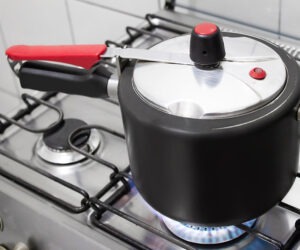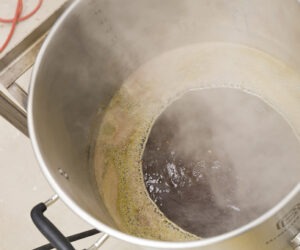Mash Hopping Techniques
New ideas in homebrewing come from many sources. Sometimes a new homebrewing idea is actually an old brewing idea that has been discovered through historical research and revived. First-wort hopping is an example of this. Often a new homebrewing idea comes from the practices of commercial brewers. The current concern about hot-side aeration is an example of an idea that filtered down to homebrewing from commercial brewing. And sometimes, as seems to be the case with mash hopping, the idea comes from within the homebrewing community itself.
Mash hopping is yet another way to add hops to your beer. Adding hops during the boil has always been an option for homebrewers. Later came dry hopping, adding hops to your beer during the secondary fermentation. Lately, the idea of first-wort hopping — adding hops to your wort before bringing it to a boil — has been explored. Now, some homebrewers are even adding hops to their mash.
Similarities to First-Wort Hopping
In some ways, mash hopping is similar to first-wort hopping. For example, in mash hopping and first- wort hopping, the hops are added prior to the boil. In other ways, mash hopping is different from first- wort hopping. First-wort hopping is seen as a replacement or partial replacement for hops added in the boil. First-wort hopping contributes slightly more bitterness per amount of hops used than traditional hopping does.
Mash hopping, on the other hand, is seen as a replacement for dry hopping. Little or no bitterness is imparted to the beer, but the hop flavor and aroma of mash hopping are considered by some homebrewers to be highly desirable.
Mash hopping shares one other similarity with first-wort hopping — some homebrewers don’t think it works. Discussions of mash hopping in various homebrewing chat rooms are fairly evenly split between people who believe in mash hopping and people who have tried it and claim that the hops added to their mashes couldn’t be tasted. For example, one homebrewer, Mike Karnowski, reported to the Home Brew Digest that he added 6 ounces of Cascades pellet hops to his mash and they yielded no hop bitterness, flavor or aroma.
Even among mash hoppers, there are some differences of opinion as to what, exactly, mash hopping does. Some mash hoppers claim that it imparts an excellent hop flavor, but no aroma, while others say that hop aroma remains. The jury is still out.
The Variables that Affect Mash Hopping
That mash hopping yields little hop bitterness is not surprising. Hop bittering compounds need to be isomerized in the boil and the temperatures of the mash are not high enough to do this. The hops are left behind in the mash tun when the wort is recirculated and run off so they are never boiled.
What is surprising, is that flavor and perhaps aroma are carried over all the way from the mash to the finished beer. Most of us homebrewers were taught that late hop additions were needed to preserve hop flavor and aroma. If you added hops too early, these compounds would boil off. Through experimenting with mash hopping and first-wort hopping, however, many homebrewers are finding that this just isn’t always true.
Some hop flavor and aroma remains even for early hop additions, including first-wort hopping and mash hopping. Paddock Wood Brewing Supplies, on their homepage (www.paddockwood.com), speculate that hop flavor and aroma compounds may somehow get bound more tightly to other wort compounds at typical mash pH’s than at boil pH’s. Why this binding process doesn’t reverse itself during the boil when the pH drops is left unexplained.
Pellet hops are believed to work better than leaf hops for mash hopping. This makes sense because leaf hops need the agitation of the wort to break open their oil glands. The glands won’t be broken open just sitting in the mash. In contrast, the oil glands in pellet hops are ruptured in the pelletization process. In the mash, the pellets are free to break apart, releasing the oils.
Thinner mashes bring out more hop flavor than thicker mashes. This is consistent with what we know about the solubility of hop compounds in wort. The thicker the wort, the less hop bitterness is extracted from hops added during the boil. A thicker mash should likewise extract fewer flavor and aroma compounds as well.
Mash hopping supposedly works better in soft water values than in hard water. This is partially consistent with brewing theory. Beers brewed in hard water are perceived as having a harsher bitterness than beer brewed in soft water. Proponents of mash hopping claim that hard water produces a better hop flavor. However, hard water supposedly also contributes to a perception of more hop bitterness. Critics of mash hopping who have brewed in hard water claim that they can’t taste the hops. This is the opposite of what would be expected.
Noble hops supposedly work well for mash hopping, while American hops work poorly or not at all. It seems strange that some hops should work and others shouldn’t. If one provided better flavor than the others, that could be understood. But that one type of hops simply wouldn’t work at all is hard to understand. Obviously more research needs to be done.
Putting Mash Hopping to the Test
I decided to see for myself if mash hopping worked, and if so, how it stacked up to other hopping techniques. I performed a quick, “semi-scientific” experiment to test the differences between mash hopping, first-wort hopping, and traditional hopping (adding hops during the boil). In the experiment, I did not test every possible permutation of mash thickness, water hardness, or hop type. I used conditions that proponents of mash hopping claimed were most favorable to the technique. Since mine was the only palate in the experiment, this should be taken more as a test trial than any source of scientific proof of the effects of mash hopping.
I made four identical mashes with one pound of pale malt. The mashes were contained in four identical beer pitchers and incubated for one hour at 150° F in my oven. After mashing, I transferred each mash to a nylon mesh bag and placed the bag in a large kitchen strainer. I sparged with enough 170° F water to yield a wort with a specific gravity of about 1.048.
I added a mixture of noble hops to each of the treatments. The amount of hops was equivalent to 14 HBU (boiled for one hour) in a 5-gallon batch. For the mash hopping treatment, hops were added immediately after mashing-in. For the first wort hopping treatment, hops were added to the wort just prior
to boiling.
I boiled all of the worts for one hour. I added the same mix of hops to the traditional hopping treatment at the beginning of the boil. The final wort was a negative control and I didn’t add any hops. After boiling I cooled all the worts to room temperature.
I tested each treatment for hop bitterness and flavor by tasting each wort. Due to time considerations, I didn’t make beer from the wort. (This ruled out expanding the experiment to include dry hopping.) Fermentation reduces the overall level of hop bitterness, but it should affect each of the treatments equally. For each treatment, I tried to assess the quality and the relative quantity of the hop flavor and bitterness. To compare the relative quantity of hop bitterness, I used unhopped wort to dilute the most bitter wort to the levels of the less bitter worts. The proportion of hopped wort to unhopped provided the basis to make the assessment (at least semi-) quantitative. The results of the hopping experiment are given above in Table 1.
The Results
My preliminary experiment suggests that mash hopping works as claimed, but be prepared to add a lot of hops to your mash tun. The mash-hopped wort had a small but noticeable amount of bitterness. There was somewhat more hop flavor and aroma present.
The bitterness of the first-wort hopped and traditionally-hopped worts was very similar, and much higher than the mash-hopped wort. In my experiment, the traditionally- hopped wort was the most bitter, but not by much. Since it didn’t take long to heat these worts from mash temperature to boiling, it isn’t surprising that the first-wort hopped and traditionally hopped treatments were so similar. The first-wort hops were only in their wort slightly longer than the hops from traditionally hopped treatment were. (Why the first-wort hopped wort was slightly less bitter is a mystery.)
The hop flavor and aroma from the first-wort hopped and traditionally-hopped worts was over twice as high as the mash-hopped wort. (See Table 1 for how these compared.) However, I thought the qualities of the hop flavor and aroma were a bit more refined and pleasing in the mash-hopped wort. This perception remained after I diluted the other worts with unhopped wort to equalize the amount of flavor and aroma among the treatments.
These preliminary results suggest that hop flavor and aroma are extracted in the mash and survive the boil. But to get normal levels of these in your beer, you’ll need to add larger amounts of hops.Try replacing your usual amount of flavor hops with 2 to 2-1/2 times that amount of hops.
Mash hopping is a very new idea and there is no published research on the procedure at this time. All the available information about mash hopping comes from homebrewers exchanging information about their brewing experiences and experiments.
Like many new and mostly untested ideas, opinions about its merits vary wildly. Many proponents of mash hopping have an almost evangelical fervor about getting the word out about mash hoping. Others claim there is absolutely nothing to support the claims of mash hoppers.
You have a couple options if you are curious about mash hopping. The first option is to sit back and wait until more is known about the procedure. The second option is just to dive in and try it. The worse thing that can happen is you might end up with a too-sweet batch of beer. Given the hop-pleasant flavor from my experimental wort, I definitely plan to try mash hopping in my next batch of beer.
What Next?
By now, we homebrewers have just about exhausted our options of when to add hops to beer. We can add them to the mash, to the first wort, to boiling wort and in secondary fermentation. Some brewers even add hop cones directly to finished beer in their glasses, and there are others infuse their brewing and sparge water with hops. I suppose we could try malt hopping, adding hops to the barley as it is steeped, germinated and kilned. Or maybe farmer’s-field hopping, sowing the ground of the barley field with hops. Who knows what the future holds?



